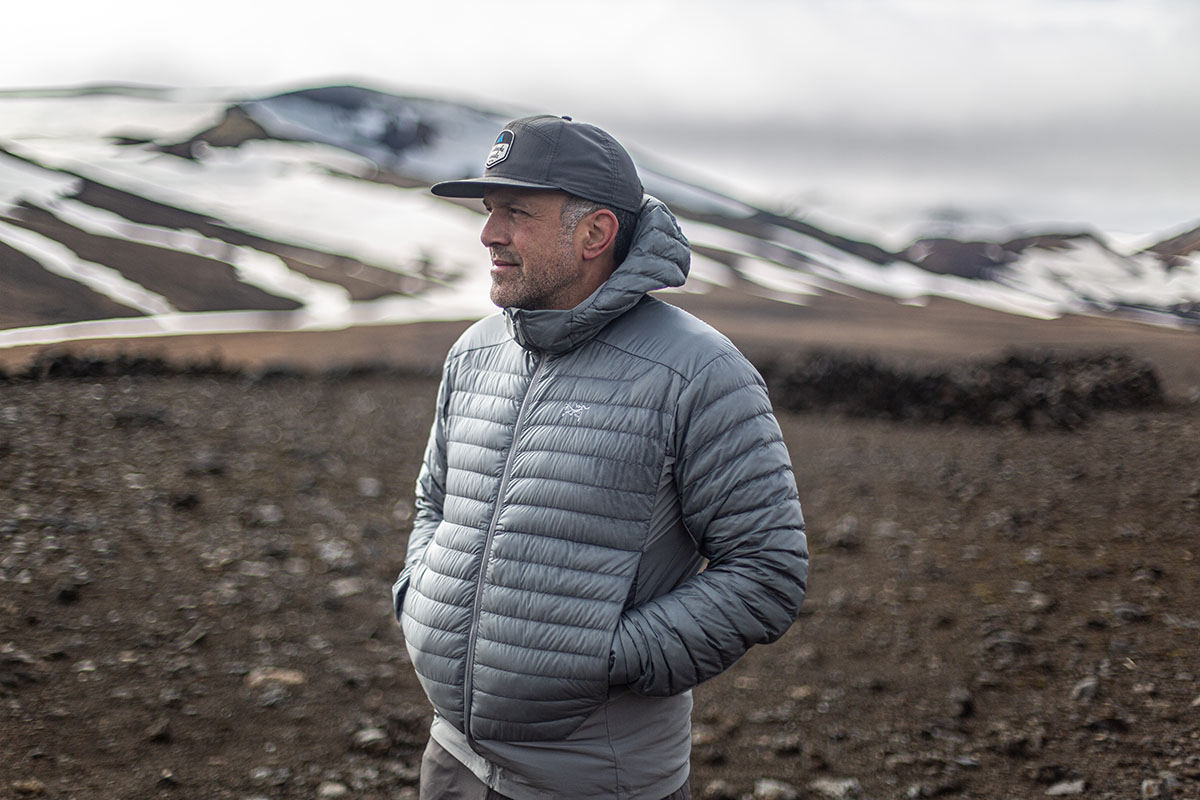
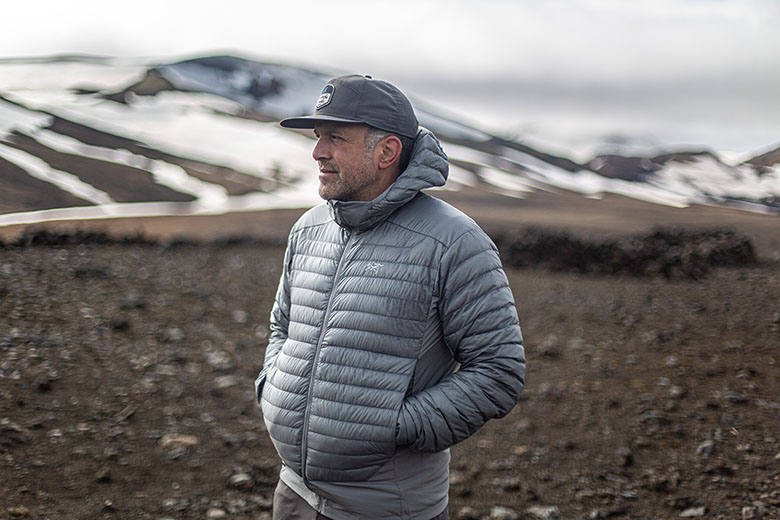
Price: $350
Weight: 9.9 oz. (men’s large)
Fill: 1.7 oz. of 850-fill-power down; 40 & 100g Coreloft
What we like: Highly effective balance of lightweight warmth and breathability for working hard in mild to cool conditions.
What we don’t: Minimally insulated and limited wind resistance.
See the Men's Arc'teryx Cerium Hybrid Hoody
Arc’teryx makes some of our favorite insulated jackets, from breathable and weather-ready synthetics to premium down pieces. The Cerium Hybrid Hoody is part of the brand’s popular Cerium collection, which combines both types of insulation to balance warmth and weather protection. The Hybrid model also tacks on air-permeable softshell panels in sweat-prone areas, making it viable for upping the heart rate in mild to cool temperatures. It’s decidedly limited on warmth and wind resistance, but for summer and shoulder-season activities like hiking and backpacking, we love the combination of light insulation, moisture resistance, and breathability. Below we break down our impressions of the Cerium Hybrid Hoody. To see how it stacks up to the competition, see our articles on the best down jackets and best midlayers.
We’ll start by noting that the Arc’teryx Cerium Hybrid Hoody is the lighter-weight sibling of the popular Cerium Hoody, with just 1.7 ounces of 850-fill down compared to 4.3 ounces in the latter (for a men’s size large). You also get a nice mix (40g and 100g) of Coreloft synthetic insulation in areas most prone to getting wet—the collar, shoulders, and cuffs—along with softshell panels under the arms, down the sides, and around the lower stomach for added breathability and stretch. Taken together, the Cerium Hybrid provides adequate warmth in mild weather and during stop-and-start pursuits but is decidedly limited on insulation for colder conditions or mostly sedentary activities. 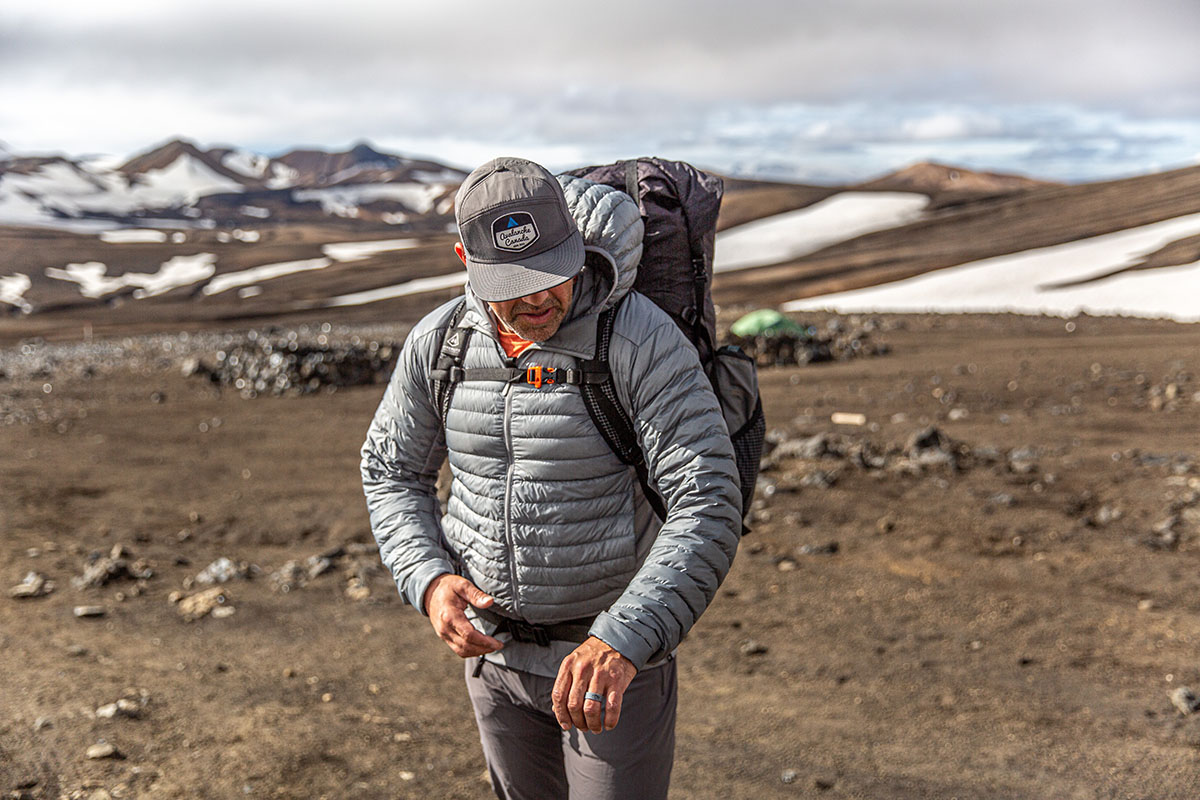
I tested the Cerium Hybrid Hoody while backpacking in Iceland and found it to be a good match for working hard in cooler temperatures, which ranged from around freezing to the mid-50s Fahrenheit. I did need to swap the Cerium out for my warmer Norrøna Falketind Down750 (which contains 3.5 oz. of 750-fill down) when the mercury dipped any lower, and I frequently added a hardshell (Arc’teryx’s own Beta Lightweight Jacket) overtop to fend off chilly gusts. On the bright side, the Cerium’s limited warmth and above-average breathability meant that I was able to keep it on for extended periods without overheating, which is especially impressive considering I run noticeably warm. I did need to unzip the Cerium on steep sections of trail and during the midday heat, but that would have been true of any down jacket. All told, while the standard Cerium Hoody remains my go-to for cool days in fall and early winter, the Hybrid is a nice substitute during warmer shoulder-season weather or at elevation in the summer months.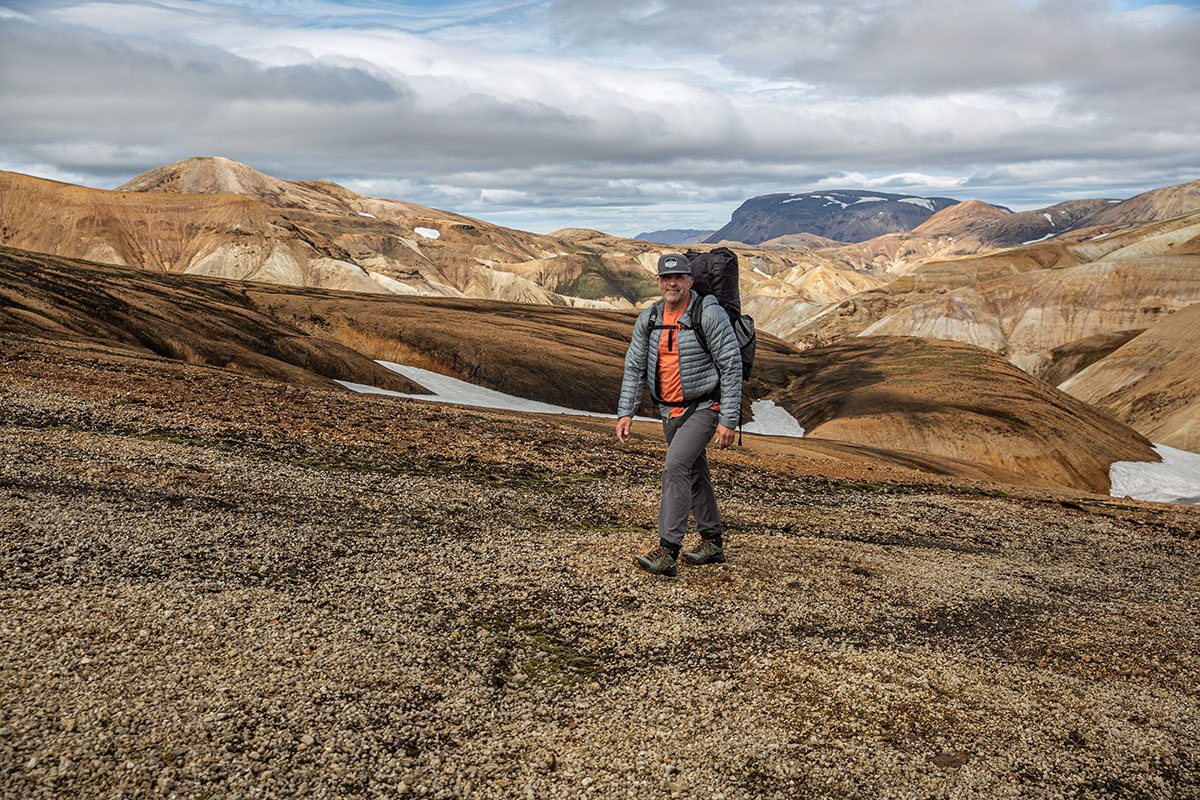
As I mentioned above, the Cerium Hybrid’s strategically placed softshell panels go a long way toward increasing airflow and overall breathability. In short, it’s a sizable step up from most competitors in terms of temperature regulation and one of the only down jackets I’ve been able to keep on during exertion without overheating. It’s not a perfect solution by any means—the interior has a tendency to grow clammy with sweat and moisture, for example—but I feel that Arc’teryx pulled off a really effective balance between warmth and breathability with the Cerium Hybrid. It’s a pretty niche design and a pricey one at that, but for the right user (think ultralight hikers and backpackers who want to fend off a chill without quickly sweating out of their jacket), the softshell panels are a nice addition.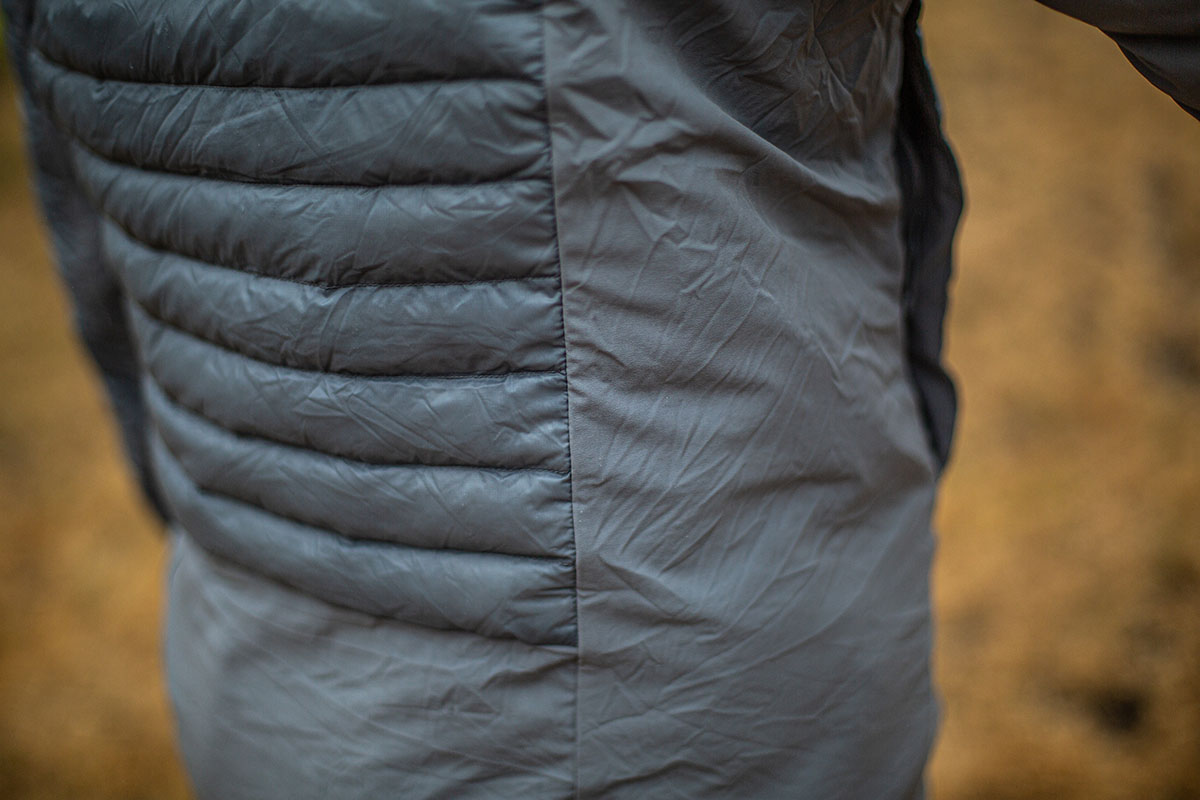
The Cerium Hybrid Hoody is an unapologetically minimalist piece, so the jacket’s scant 9.9-ounce weight (on my scale for a men’s large) came as little surprise. Comparing the Cerium to other leading UL models, it’s right in line with most of the competition: The Mountain Hardwear Ghost Whisperer/2 Hoody (insulated with 3 oz. of 800-fill down) checks in a little lighter at 8.8 ounces, while Feathered Friends’ Eos Down Jacket is both heavier (10.8 oz.) and warmer (4 oz. of 900-fill down). However, it’s worth noting that these comparisons aren’t exactly apples to apples since both of those jackets exclusively use down fill, whereas the Cerium Hybrid adds synthetic on top of its 1.7-ounce down fill weight. 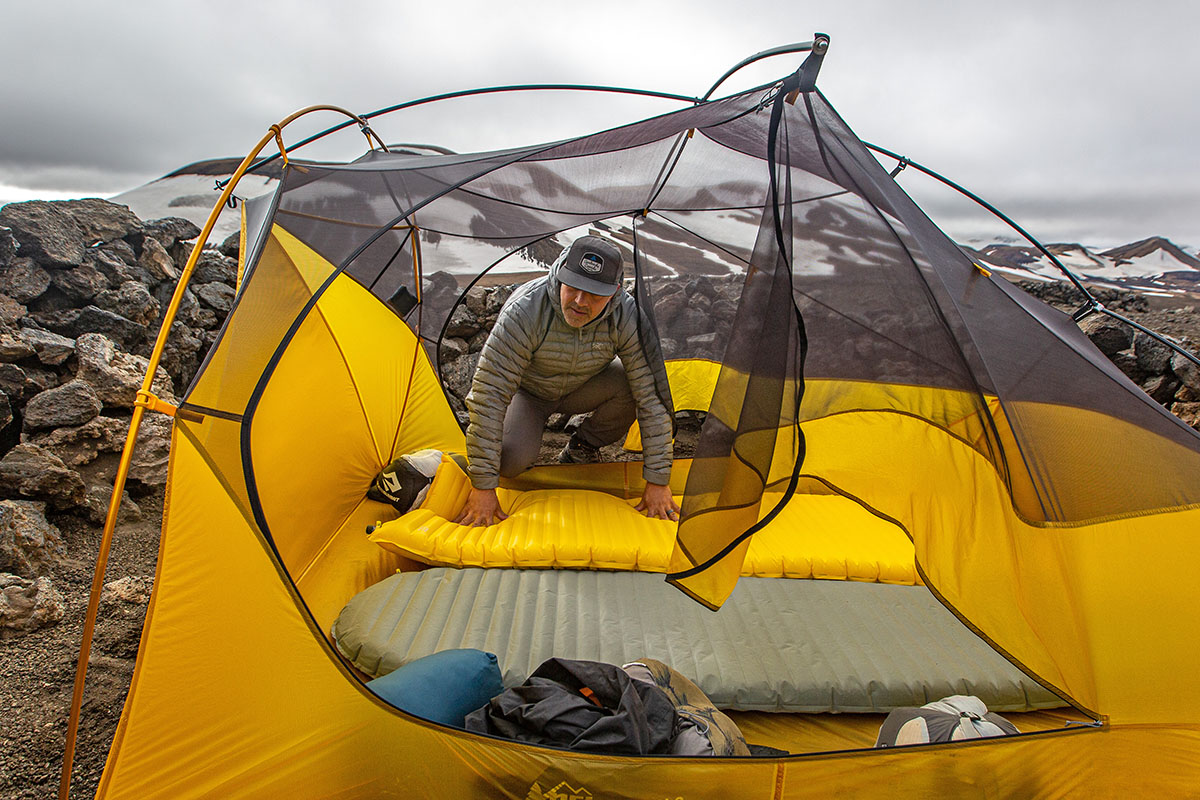
In terms of packability, the Arc'teryx Cerium Hybrid Hoody stuffs down easily into its included storage sack, compressing to about the size of a large cantaloupe. You can get it even smaller by using a dedicated compression sack, but I often just stuff the jacket into its hood for quick and easy storage. Regardless of your packing method, the Cerium Hybrid Hoody is compact enough that I never hesitate to bring it along on stop-and-start adventures (e.g., transitioning while ski touring or taking a lunch break while hiking) or when temperatures might dip.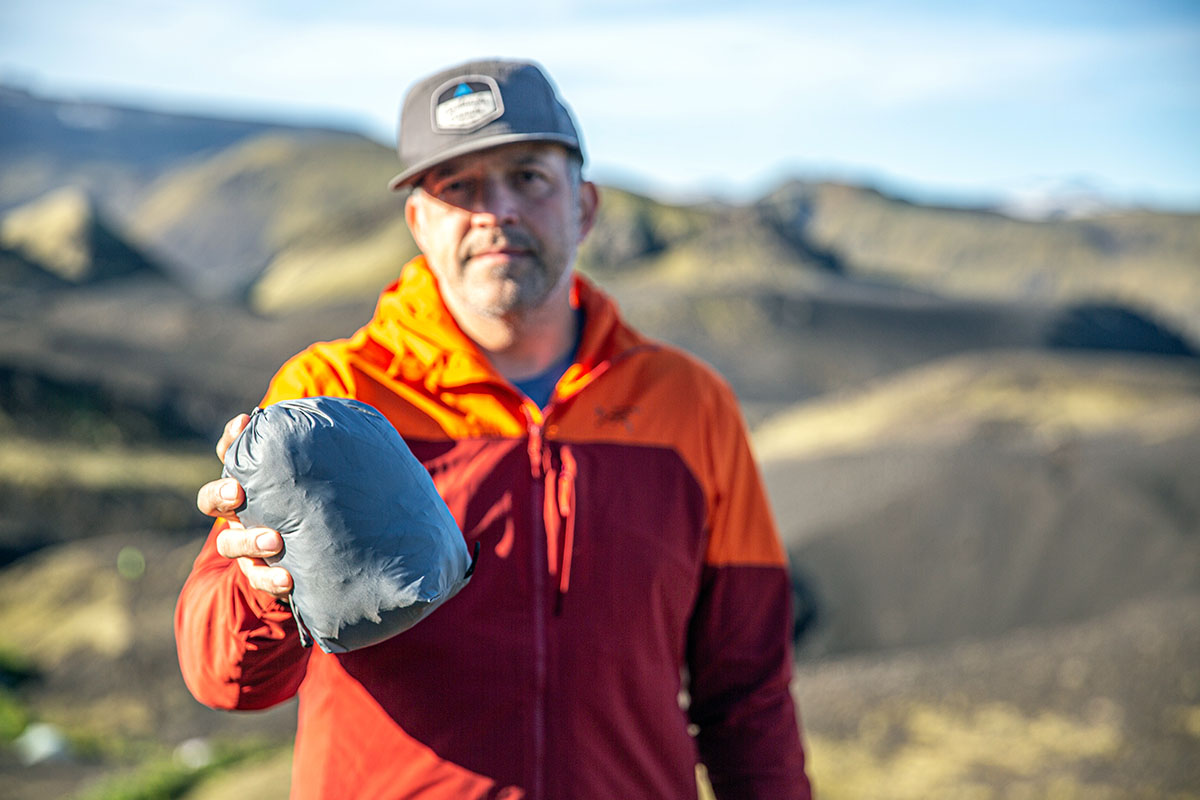
Right away, it’s important to note that the Cerium Hybrid Hoody isn’t an ideal outer layer. In addition to having a noticeably trim fit (more on this in “Fit and Sizing” below), the jacket’s down insulation limits its ability to handle inclement weather—unlike synthetic fill, down clumps up and loses its insulating abilities when wet. As I mentioned above, Arc’teryx did utilize synthetic Coreloft in moisture-prone areas like the collar and shoulders, which brings some additional confidence in snow and light precipitation. The shell also boasts a durable water repellent (DWR) finish, which helps moisture bead up and roll off the surface rather than soak through. In practice, the Cerium held up to light mist for a while but eventually wet out from extended exposure. In my opinion, it’s best to bring along a waterproof rain jacket or hardshell anytime inclement weather is in the forecast.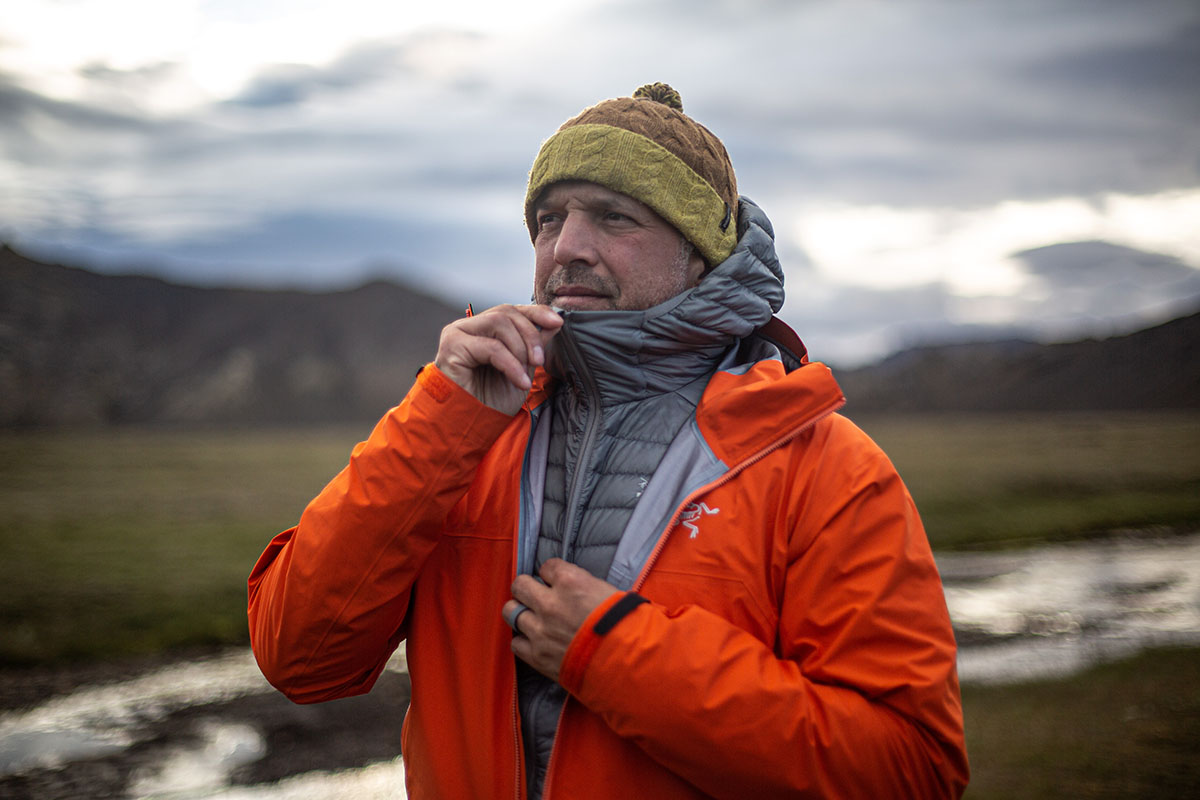
It’s a similar story with wind resistance: The Cerium Hybrid Hoody is designed with breathability in mind, and the Fortius 50 softshell fabric is air-permeable enough that it feels noticeably drafty in blustery weather. The hem drawcord and elasticized cuffs do help with sealing out drafts, but again, it’s not intended to be a protective outer layer. If wind is more of a concern than moisture, it might suffice to bring along a lightweight windbreaker jacket rather than a full-on rain shell.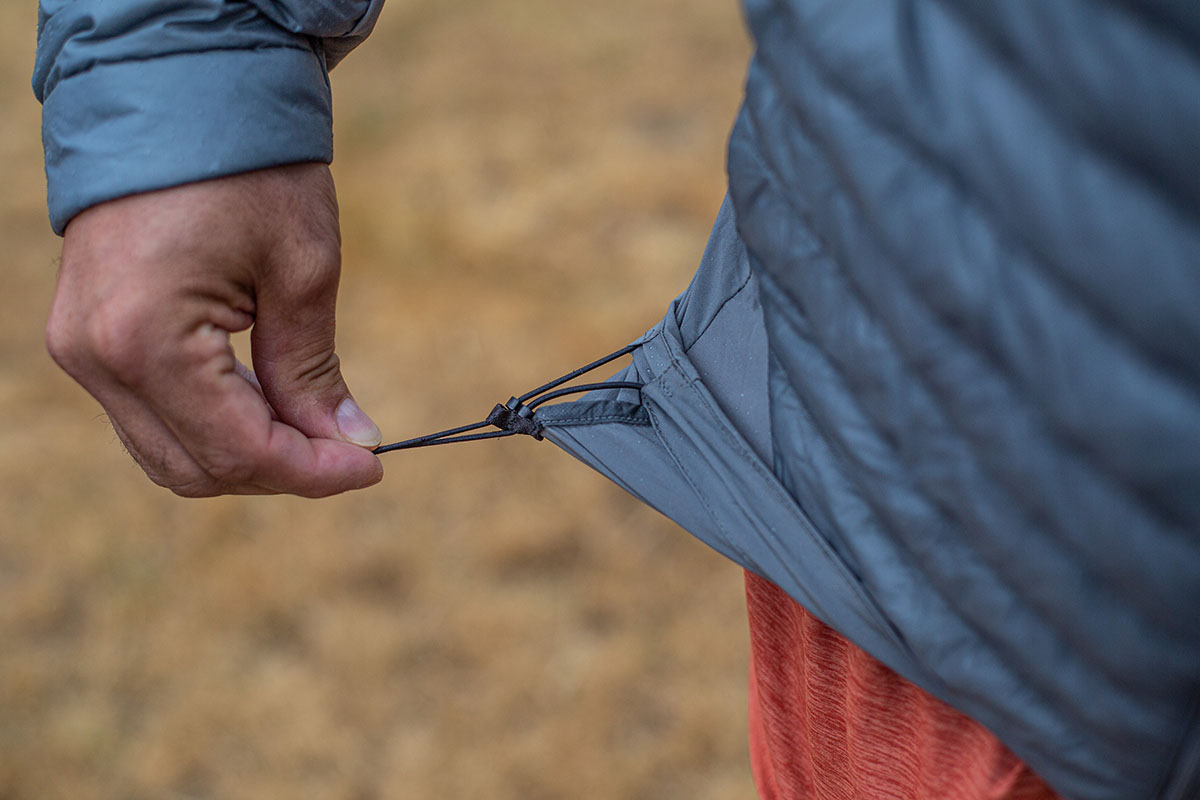
It’s common to see ultralight pieces utilize thin fabrics to keep weight to a minimum, and the Arc'teryx Cerium Hybrid Hoody is no exception with a 15-denier (D) shell. However, despite its delicate feel, the jacket has held up without issue thus far. The down has bounced back to its original loft after wetting out, and there are no rogue feathers protruding from the seams or baffles. Similarly, the Fortius Air 50 softshell panels are in great shape with no signs of abrasion or wear despite frequent contact with backpack straps and sharp lava rocks in Iceland. The main zipper has a relatively fragile feel and can be a bit finicky to operate given its small size, but it still functions as intended and hasn’t given me any major problems. As with all UL gear, you’ll want to exercise caution around sharp equipment and rough surfaces like branches and rocks, but I’ve been impressed by the Cerium Hybrid’s ability to withstand significant use and abuse.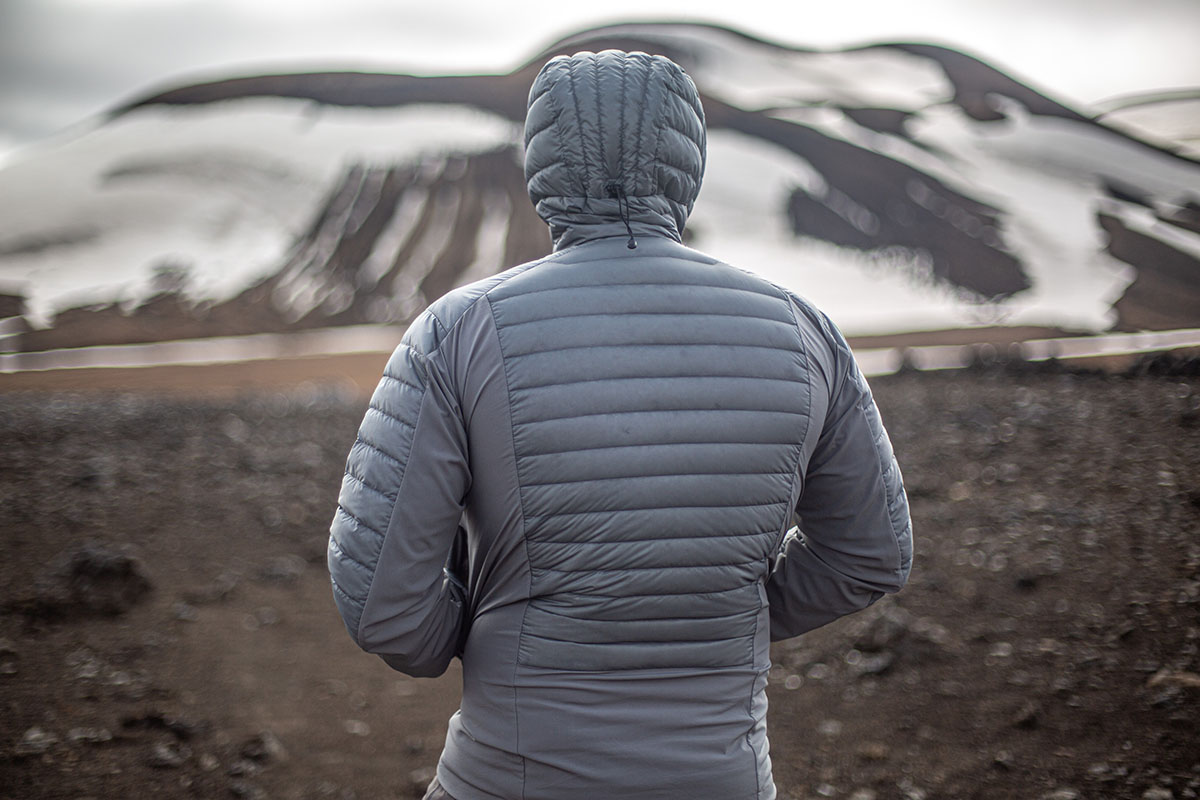
Arc’teryx’s StormHood has been a staff favorite for years and is a functional addition to the Cerium Hybrid. The design is adjustable via a single drawcord at the back of the head, which was particularly helpful in Iceland’s strong and frequent winds. Importantly, the cinch cord is easy to access and operate with one hand or while wearing gloves, and the hood stays securely in place when tightened. It’s also large enough to comfortably fit over a ball cap or beanie and can squeeze over a climbing helmet in a pinch (although it’s too snug to work with a ski helmet). All in all, I have very few complaints about the design and enjoyed the added warmth on chilly mornings and evenings at camp.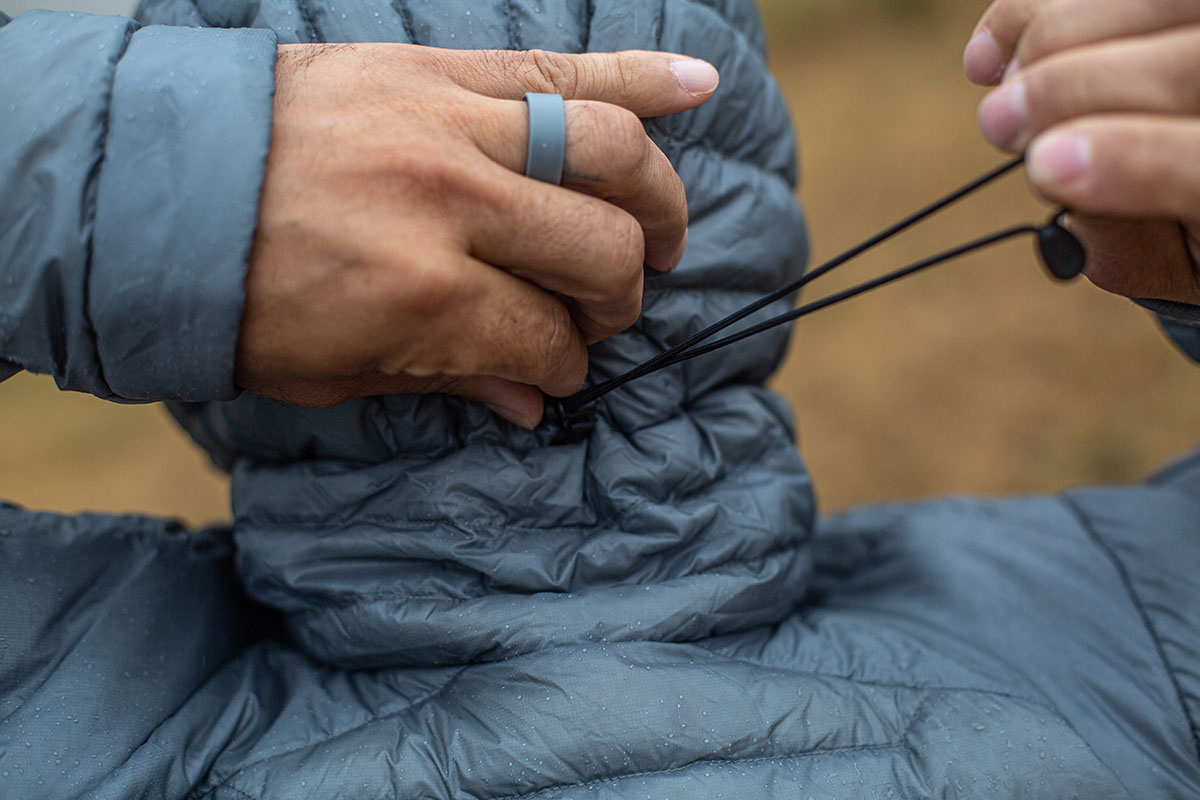
Arc’teryx kept things simple with the Cerium Hybrid Hoody’s storage layout, which comprises just two hand pockets. To be fair, the pockets are generously sized and comfortably fit gloved hands or large items like a camera lens or beanie. They’re also positioned high enough to access while wearing a backpack or climbing harness, and the left pocket contains the removable stuff sack for packing the jacket down (bonus: Arc’teryx included an attachment point inside the pocket, which makes it harder to lose). I do think that adding an internal chest pocket for smaller valuables like a phone or wallet would be worth the weight penalty, but I understand Arc’teryx’s decision to keep things as streamlined as possible.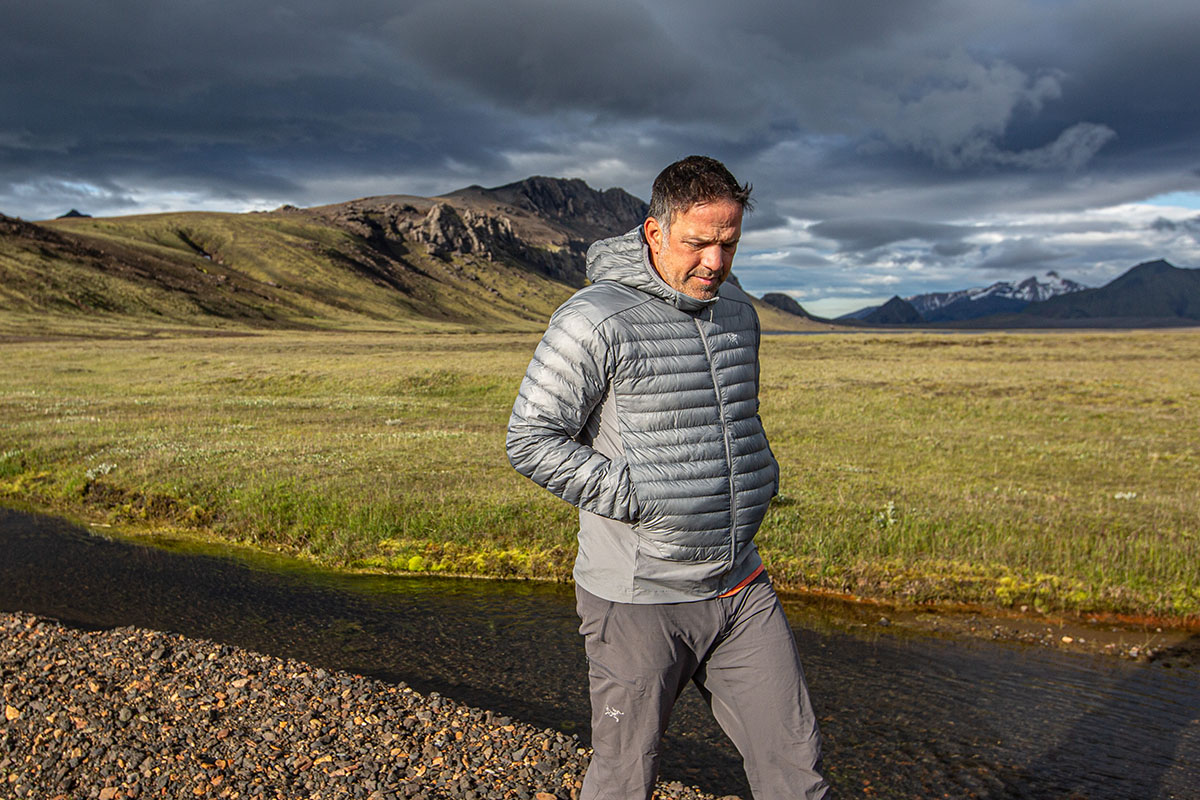
I typically wear a large in Arc’teryx jackets, and the Cerium Hybrid Hoody fit true in my standard size. For reference, the jacket is listed as “fitted,” which means it’s designed to fit close to the body to allow for layering overtop. I would agree that the fit is decidedly athletic, but not so much so that it restricts movement. For reference, I was able to fit both a merino wool T-shirt and a lightweight fleece jacket underneath the Cerium Hybrid, but I’d likely need to size up to accommodate any additional (or thicker) layers. However, I don’t love where the baffles and softshell fabric meet at the lower stomach—the baffles protrude a little, while the softshell sits flush against the belly, which isn’t all that flattering on those of us who carry a little extra weight in our midsection. Thankfully, the softshell panels are noticeably stretchy and allow for ample mobility. And length-wise, there’s ample coverage both at the arms and waist when reaching overhead or bending down.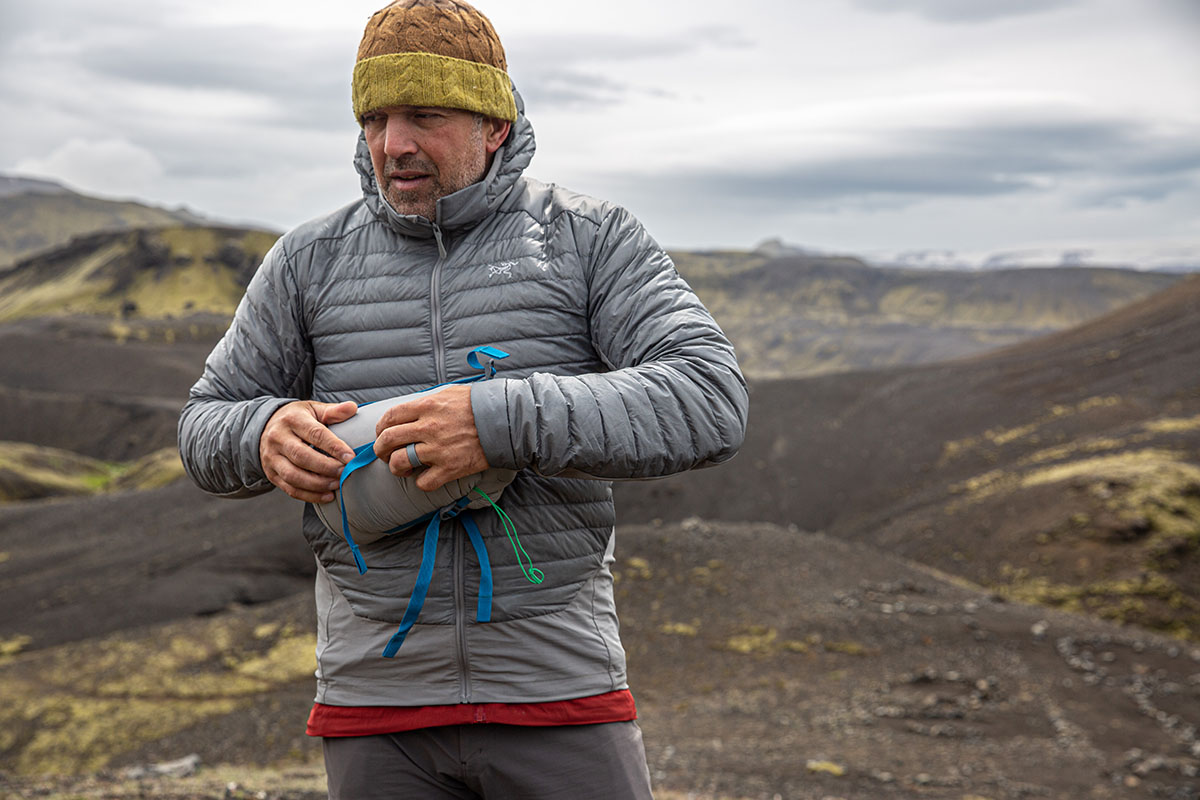
Arc’teryx has made notable strides on the sustainability front of late, and the Cerium Hybrid Hoody is a nice reflection of their ongoing progress. For starters, the down insulation is certified to the Responsible Down Standard (RDS), which ensures the geese were treated humanely (e.g., no force-feeding or live-plucking). The jacket also utilizes bluesign-approved materials that have been deemed safe for workers, consumers, and the environment, while the shell is dope-dyed to limit water and energy use. Finally, the Cerium Hybrid Hoody contains raw materials—at least 30% of which are recycled—and uses a PFC-free DWR finish that forgoes the use of harmful perfluorocarbons. Taken together, it’s a comprehensive and laudable effort from the North Vancouver-based brand. 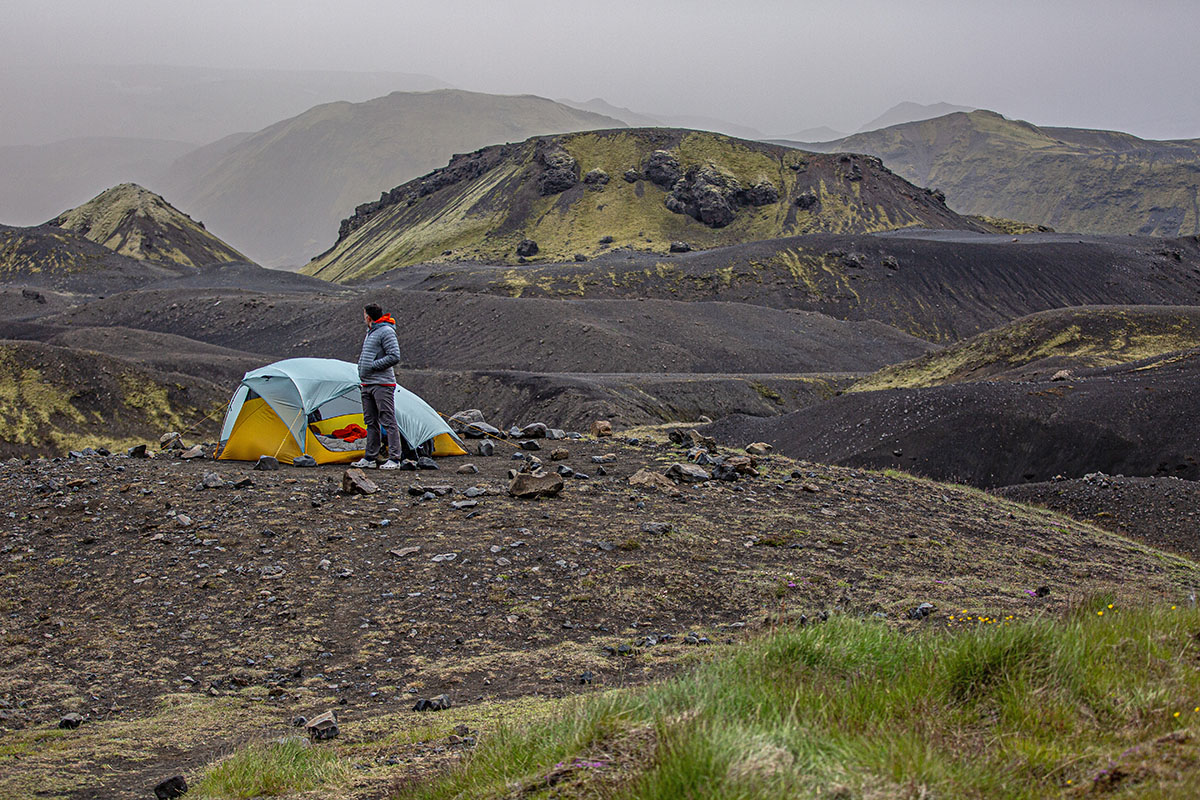
The Cerium Hybrid Hoody is currently only offered in a men's model, but the wider Cerium collection contains several other options in both men's and women's styles. The most popular is the standard Cerium Hoody, which retails for $50 more than the Hybrid. Comparing the two, the standard Cerium is heavier at 11.9 ounces for the men’s version but offers a noticeable boost in warmth with 4.3 ounces of 850-fill down (again, in a men's large) and a mix of 80 and 100g Coreloft. There’s also a non-hooded Cerium Jacket ($380), which clocks in about an ounce lighter than the hoody at 10.6 ounces for the men's version. Rounding out the lineup, the Cerium is offered in a vest style ($300) for men and women, as well as a women’s-specific Lightweight Hoody ($360) that trims weight with an ultra-thin 7D shell and minimalist feature set. 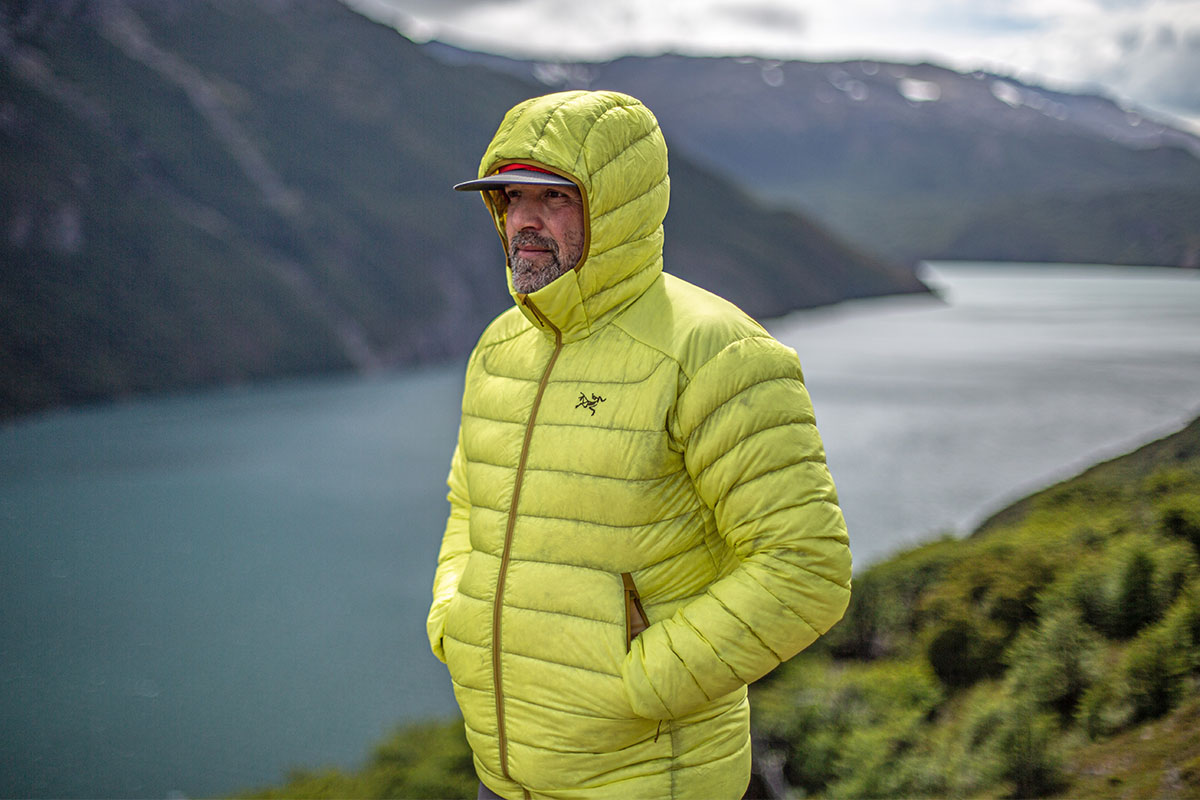
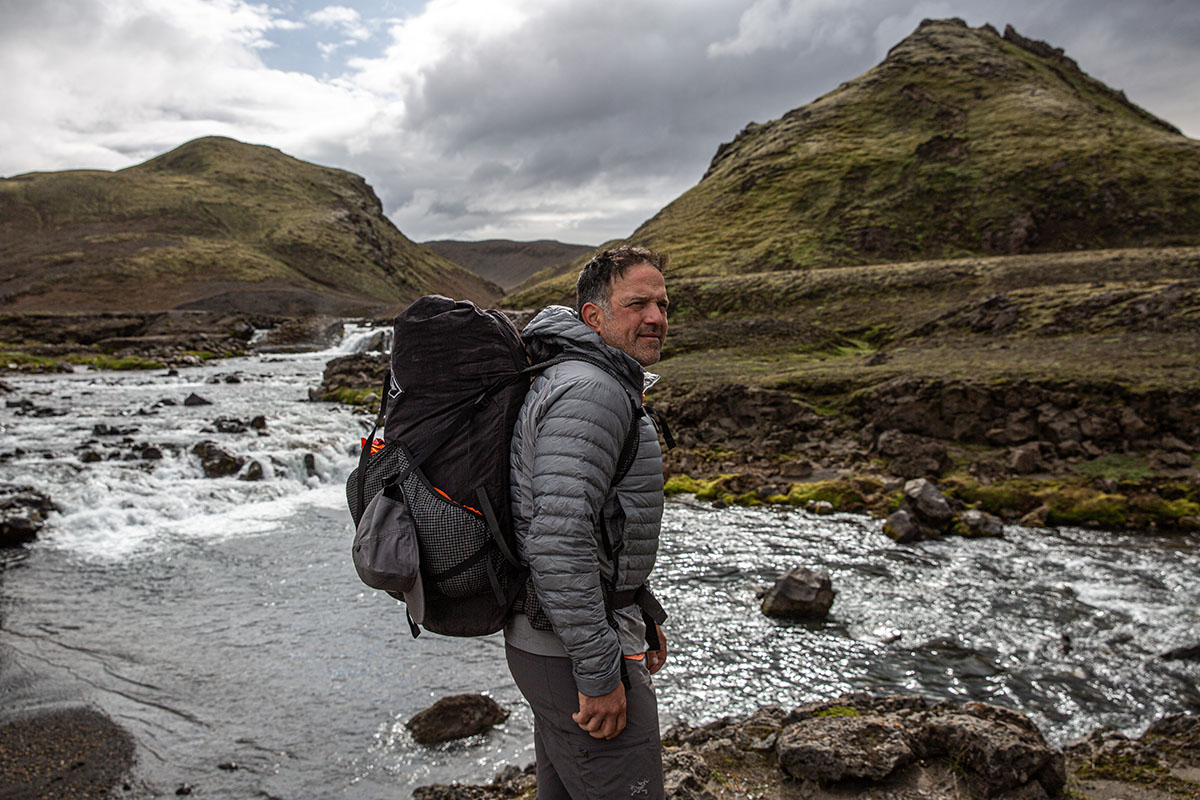
| Jacket | Price | Weight | Fill | Fill Weight | Denier |
|---|---|---|---|---|---|
| Arc'teryx Cerium Hybrid Hoody | $350 | 9.2 oz. | 850-fill down & Coreloft | 1.7 oz. & 40/100g | 15D |
| Arc'teryx Cerium Hoody | $400 | 11.9 oz. | 850-fill down & Coreloft | 4.3 oz. & 80/100g | 15D |
| MH Ghost Whisperer/2 Hoody | $360 | 8.8 oz. | 800-fill down | 3 oz. | 10Dx10D |
| Rab Mythic Alpine Light | $330 | 8.8 oz. | 900-fill down & PrimaLoft | 2.8 oz. | 10D |
| Arc'teryx Atom Hoody | $300 | 13.1 oz. | Coreloft | 60g | 20D |
The Cerium Hybrid Hoody offers an effective combination of warmth and breathability for keeping you comfortable while on the move, but it’s an undeniably specialized and niche down jacket. For most, the standard Cerium Hoody mentioned above will be the better match: While a little heavier at 11.9 ounces, it’s warmer with around 4 ounces of 850-fill down and a thicker mix (80 and 100g) of synthetic Coreloft in moisture-prone areas. You also get an internal zippered pocket for stashing small valuables, along with an upgraded reverse-coil (i.e., more streamlined) main zipper. Ounce-counters and those looking for more of an active insulation piece can save $50 with the Hybrid, but the standard Cerium is far and away the better all-rounder with a wider temperature range (for more, see our in-depth Cerium Hoody Review).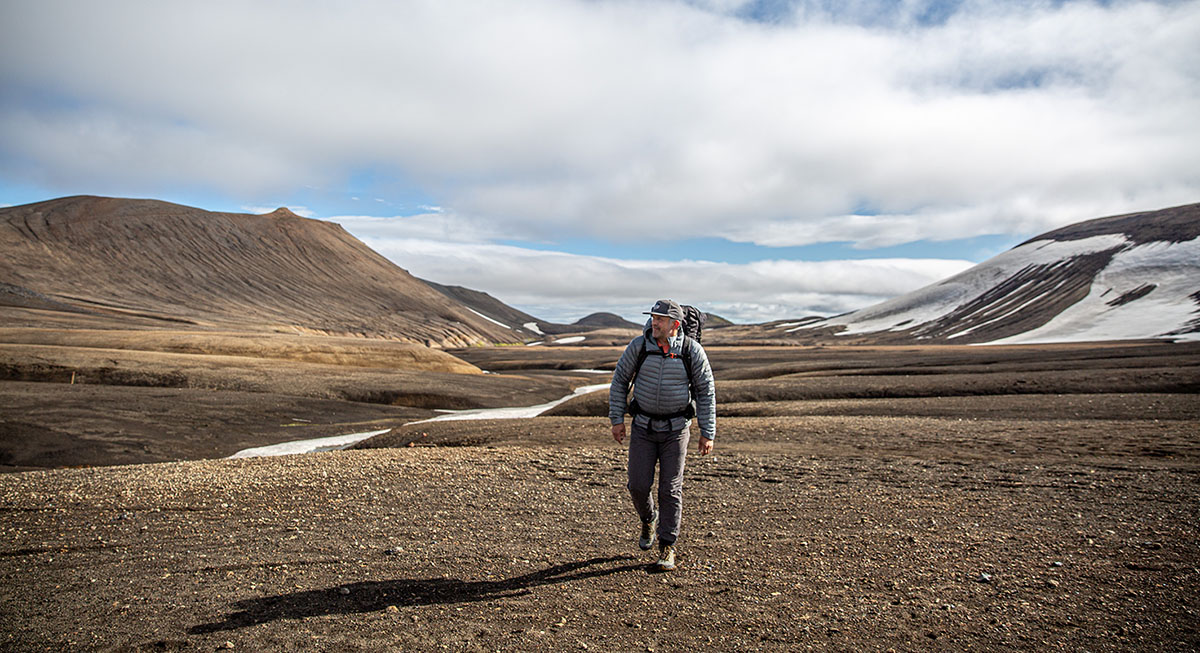
Mountain Hardwear’s Ghost Whisperer/2 gives the Cerium Hybrid Hoody a run for its money when it comes to warmth relative to weight. For 0.4 ounces less, the Ghost Whisperer offers a modest bump in warmth with 3 ounces of 800-fill down and retains similar features including a hood, two zippered hand pockets, and a hem cinch. That said, the Ghost Whisperer’s hood isn’t adjustable, and its cuffs are wide and lacking in stretch, making the jacket a bit less effective at sealing out the cold. And when it comes to weather protection and breathability, the Cerium Hybrid’s use of strategically placed synthetic fill and softshell panels in high-heat areas give it the clear edge. In the end, we’d recommend the tried-and-true Ghost Whisperer for those looking to maximize warmth while keeping weight to a minimum, while the Cerium is the better match for hikers and backpackers who want more breathability than a standard down jacket.
Next up is a recent favorite of ours: the Rab Mythic Alpine Light. Starting with warmth, the Rab wins out with 2.8 ounces of even loftier 900-fill down, and it stacks up similarly in weather protection with strategically placed PrimaLoft Gold insulation and a water-resistant Pertex Quantum shell (plus, the down is hydrophobic). Impressively, the Mythic Alpine Light manages to pull this off at a slightly lower weight (8.8 oz.) and price point ($330) than the Cerium Hybrid. To make that happen, however, the design does have some concessions: The Rab’s shell is thinner at 10D, there’s no drawcord for cinching the hood, and it lacks the Cerium’s air-permeable softshell panels. If breathability is of any concern, we’d stick with the Cerium. Otherwise, the Rab strikes us as the less compromised and more versatile design.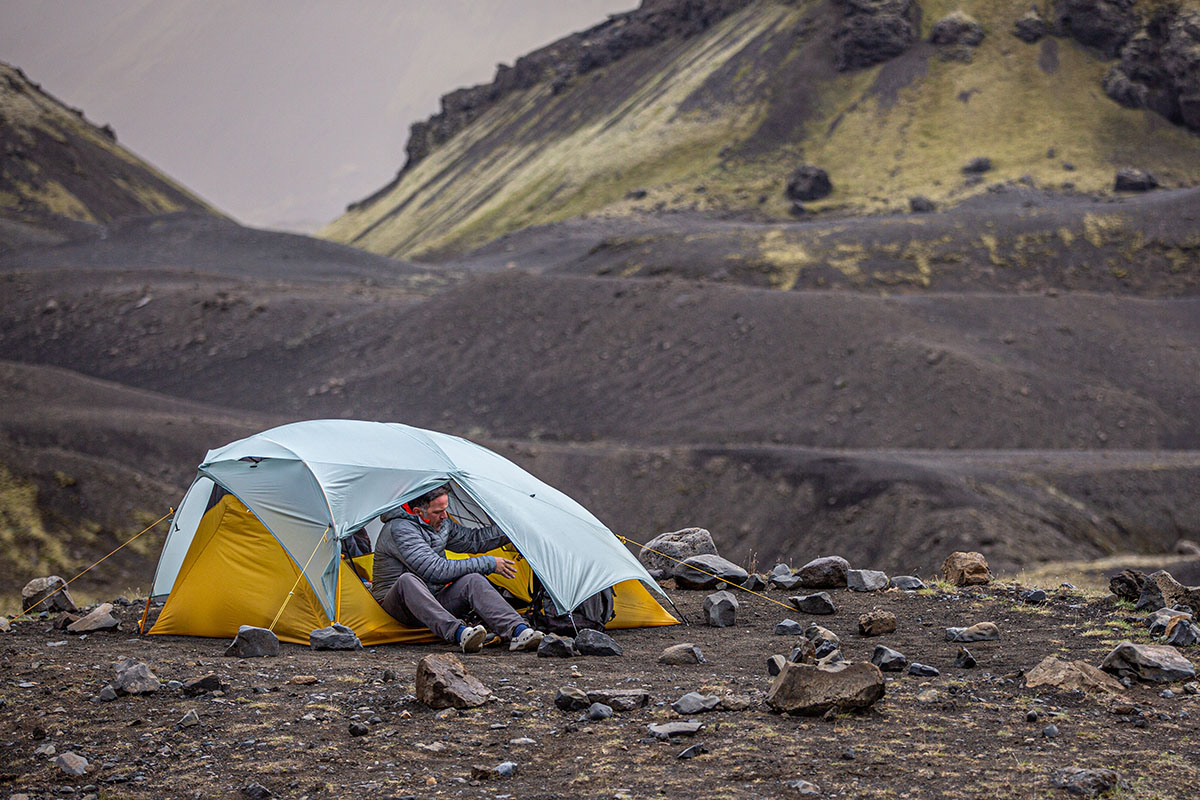
A final competitor is Arc’teryx’s Atom Hoody (formerly the Atom LT), which is insulated exclusively with synthetic fill (60g Coreloft). As we mentioned, down’s biggest enemy is moisture, making the Atom the more reliable pick when the weather turns. Weight jumps to 13.1 ounces, although this is pretty competitive for a synthetic piece, and the Atom offers solid warmth for its weight. It’s a step down in breathability from true active insulation designs like Arc’teryx’s own Proton Hoody, but we’ve found the Coreloft insulation and stretchy fleece side panels allow enough airflow to stay comfortable during activity. We love the versatility, too: The Atom works great as an outer layer or midlayer and wears well around town—unlike the Cerium Hybrid, which has a fairly technical look and works best as a midlayer. The Cerium is the better match when space is at a premium in the warmer months, but the Atom offers improved warmth, protection, durability, and versatility for a wider range of conditions and activities.